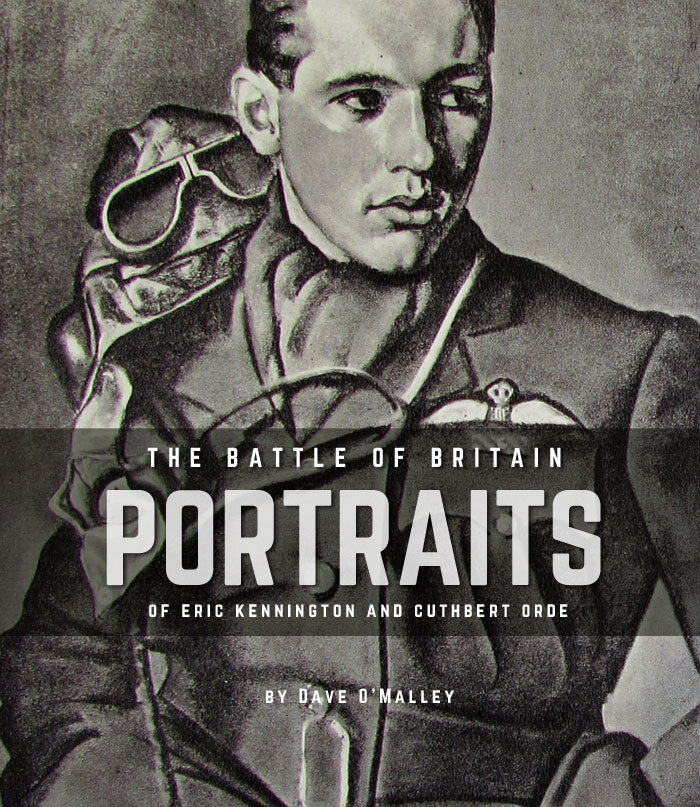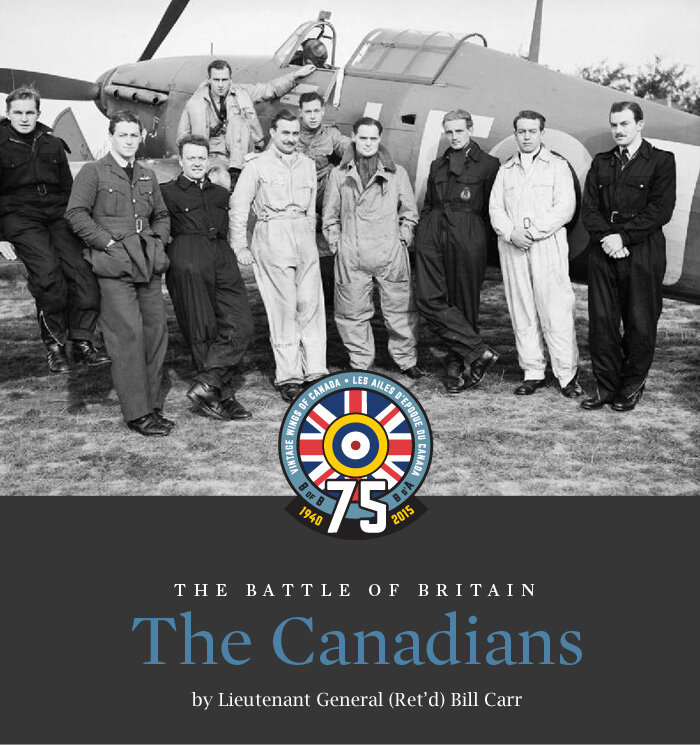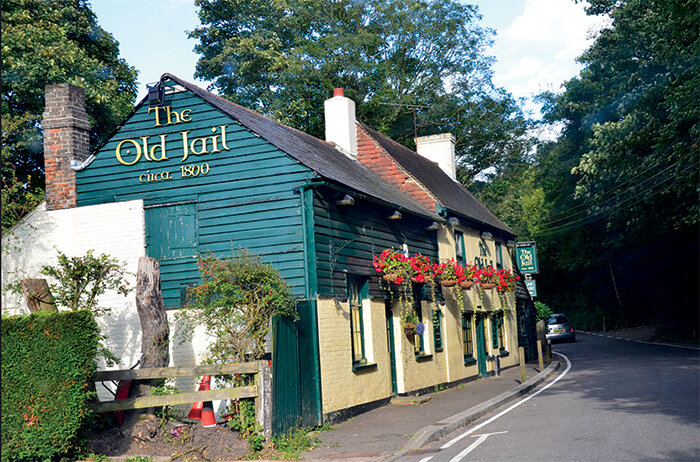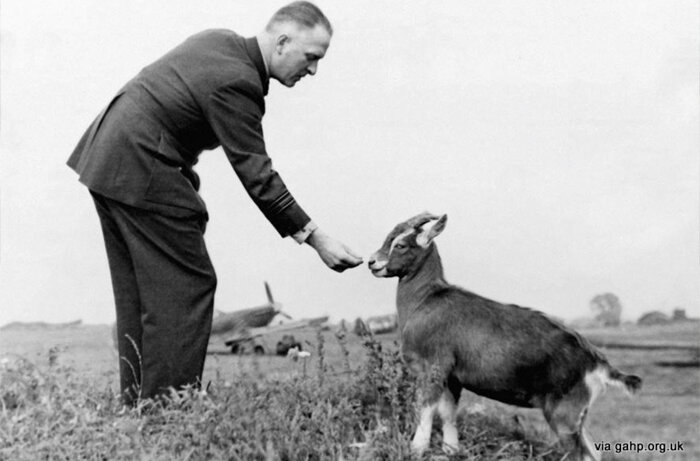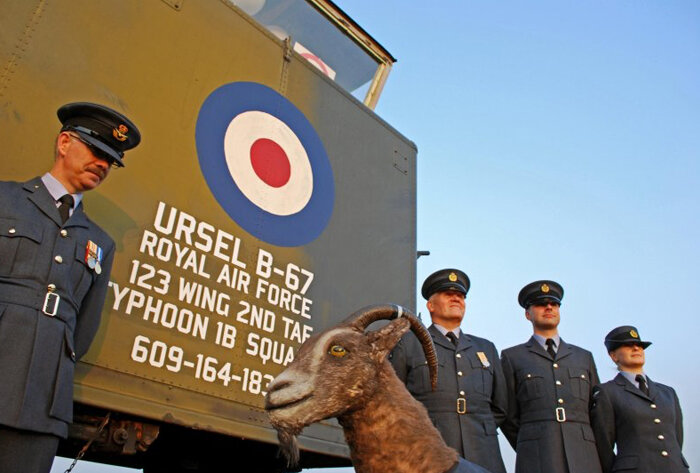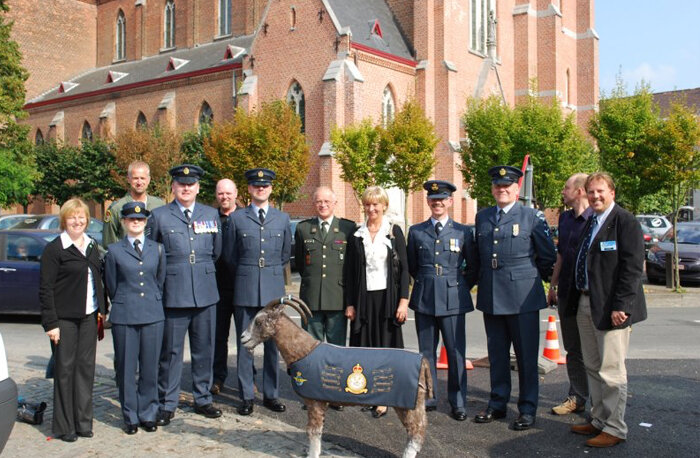OF GOATS AND MEN — John Steinbeck and the Legend of Billy de Goat
During the Second World War, hundreds of journalists, photographers and correspondents risked their lives alongside soldiers, airmen and sailors. Among them were recognized best selling-authors of the highest renown. Edgar Rice Burroughs of Tarzanfame, covered the Japanese attack at Pearl Harbour while George Orwell worked for the BBC. There were, among these men and women, two giants of American Literature who were recipients of both a Pulitzer and a Nobel Prize— Ernest Hemmingway and John Steinbeck. Hemmingway was present during the Normandy landings and later attached himself to the 22nd Infantry Brigade and covered the Battle of Hürtgen Forest. Like Hemmingway, John Steinbeck, author of Of Mice and Men, The Grapes of Wrath and East of Eden, didn't just report from the battle front, he was right in the thick of it.
In 1943, Steinbeck served as a war correspondent for the New York Herald Tribune and worked with the Office of Strategic Services (predecessor of the CIA). It was at that time he became friends with Will Lang, Jr. of Time/Life magazine. During the war, Steinbeck accompanied the commando raids of Douglas Fairbanks, Jr.'s Beach Jumpers program, which launched small-unit diversion operations against German-held islands in the Mediterranean. At one point, he accompanied Fairbanks on an invasion of an island off the coast of Italy and helped capture Italian and German prisoners using a Tommy Gun. Some of his writings from this period were incorporated in the documentary Once There Was a War. Steinbeck returned from the war with a number of wounds from shrapnel and some psychological trauma.
However, his war correspondent work was not always carried out under a hail of bullets or from a field of mud. For a while, he covered human interest stories in wartime England, visiting Allied servicemen as they fought the war from air bases and harbours in the United Kingdom and brought the fight to the continent until the day came for the great invasion of Normandy.
On November 29, 1943 Steinbeck left London to visit RAF Manston in North East Kent where RAF Hawker Typhoons of 609 and 3 Squadrons and the Hawker Hurricanes of 184 Squadron (soon to convert to the Typhoon) were conducting daily raids on French ports and military targets. While the great author witnessed operations, got introduced to pilots and commanders and got an up-close introduction to the hulking Typhoon fighter-bomber, it was the strange glycol-quaffing, cigarette munching 609 Squadron goat mascot that seemed to pique his interest most of all.
Famed author and Pulitzer Prize recipient John Steinbeck (in trench coat) meets 609 Squadron mascot Wing Commander Billy de Goat at RAF Manston on June 29, 1943. Steinbeck, a war correspondent for the New York Herald Tribune, was there to meet and cover stories of 609 Squadron's Hawker Typhoon pilots, then the highest-scoring squadron on the type in the RAF. Photo via ManstonHistory.org.uk
Officially, Steinbeck was there to write about the squadron and Typhoon operations. Here, he gets briefed by Squadron Leader Alec Ingle, DFC, AFC as Flying Officer Peter Raw, DFC, in the cockpit of a Typhoon nicknamed Mavis (named after Raw's wife), explains instruments and controls. Ingle would be shot down a few months later, surviving the war as a PoW. “Slosher” Raw, an insurance broker before the war, was one of four Raw brothers who served in the Second World War, only one of whom survived—his brother Michael. Raw (by this time a Flight Lieutenant) transferred to 183 Squadron and was killed in action over Holland in March of 1944 during a fighter sweep of six 183 Squadron Typhoons. He was hit by flak and struck the barge he was strafing at the time. The citation accompanying his DFC speaks to his courage and determination: “P/O. Raw is a pilot of exceptional courage and ability, and is always eager to hunt and engage the enemy. During a period of three months he has attacked and immobilised 17 locomotives, 11 by day and 6 by night, during offensive operations over France and Belgium. Recently he has taken part in two attacks on enemy shipping, and in the face of intense Flak has severely damaged two and scored hits on two more enemy motor minesweepers. He has also damaged a FW 190 raider.” His brother, Squadron Leader Anthony Raw, DFC, AFC, was killed a few months later flying with 156 Squadron Pathfinders, Bomber Command. A third brother, Pilot Officer John Frederick Raw had died in 1941, during night flying training, when his Miles Magister crashed. Photo via ManstonHistory.org.uk
Related Stories
Click on image
He penned a short humour piece about the goat that eventually was published in the Daily Express, a nationwide tabloid newspaper based in London. It was an extraordinary piece of fluff considering the stature if its writer, who had by that time had been awarded a Pulitzer Prize and National Book Award for The Grapes of Wrath, his powerful portrait of Oklahoman families during the Dust Bowl. Perhaps it was more in the ironic and comic style of Tortilla Flat.
Steinbeck's story today sounds a bit awkward or old-fashioned, but still it makes a fine aviation story as it demonstrates the quirky behaviour and anti-establishment attitudes of frontline fighter pilots. We republish it here as it was written after Steinbeck's visit to Manston in late 1943:
Commander Goat, D.S.O.
By John Steinbeck
His name is Wing Commander William Goat, D.S.O., and he is old in honours and some say in iniquity, but when he joined the R.A.F. wing two years ago he was just able to totter about on long and knobbly legs.
For a long time he was treated like any other recruit, kicked about, ignored and at times cursed. But gradually his abilities began to be apparent. He is very good luck to have about. When he is near his wing has good fortune and good hunting.
Gradually his horns grew and his talents developed, until now his rank and his decorations are painted on his horns in brilliant colours, and he carries himself with a shambling strut. He will eat nearly everything. No party or any review is complete without him. At one party, being left alone for a few moments, it is reported that he ate 200 sandwiches, three cakes, the arrangements for piano and flute of “Pomp and Circumstance,” drank half a bowl of punch, and then walked jauntily among the dancers, belching slightly and regarding a certain lieutenants wife, who shall be nameless.
Oxygen appetite
He has the slightly bilious look of the military of the higher brackets. Being an airgoat he has rather unique habits.
If you bring an oxygen bottle into view he rushes to it and demands it. He puts his whole mouth over the outlet and then as you turn the valve on gently he relaxes grunting happily and his sides fill out until he nearly bursts.
Just before he bursts he lets go of the nozzle and collapses very slowly, but the energy he takes from the oxygen makes him leap into the air and engage imaginary goats in horny combat.
He also loves the glycol cooling fluid which is used in the engines of the Typhoons. For hours he will stand under the barrels licking the drips from the spouts.
Indispensable
He has the confidence of his men. Once when it was required that his wing change its base of operations quickly, he was left behind, for in those days it was not known how important he was.
At the new base the men were nervous and irritable, fearful and finally almost mutinous, and at length when it was seen they would not relax a special plane had to be sent to pick up the Wing Commander and transport him to the new base.
Once he arrived everything settled down. The Typhoons had four kills within 24 hours. The nervous tension went out of the air, the food got better as the cooks ceased brooding, and a number of stomach complaints disappeared immediately.
Wing Commander Goat lives in a small house behind the operations room. His name and honours are painted over the door. It is very good luck to go to him and stroke his sides and rub his horns before going out on operation.
He does not go on operation himself. There is not room in the Typhoon for him, but if it were possible to squeeze him in he would be taken, and then heaven knows what great action might not take place.
Evil companions
This goat has only one truly bad habit. He loves beer, and furthermore, he is able to absorb it in such quantities that even the mild nearly non-alcoholic English beer can make him tipsy.
In spite of orders to the contrary, he is able to seek out the evil companions who will give him beer. Once inebriated he is prone to wander about sneering at everything.
He sneers at the American Army Air Force and he sneers at the Labour Party, and once he sneered at Mr. Churchill. The sneer is probably inherent in the beer, since punch has quite a different effect on him.
In appearance this goat is not impressive. He has shabby, pinkish fur and a cold and fish-like eye. His legs are not straight. In fact, he is slightly knock-kneed. He carries his head high, and his horns, painted in brilliant red and blue, more than offset any physical oddness.
In every way he is a military figure. He is magnificent on parade. Eventually he will be given a crypt in the Air Ministry and will die in good time of that military ailment, cirrhosis of the liver. He will be buried with full military honours.
But meanwhile Wing Commander William Goat, D.S.O., is the luck of his wing. His loss would cause great unrest and even despondency.
John Steinbeck
The Life of Billy
Billy de Goat was introduced to 609 Squadron by the famed Belgian ace, Pilot Officer Victor Marcel Maurice “Vicky” Ortmans. Aviation historian Martin Waligorski, writing for The Spitfire Site, explains Billy's early life:
“In February 1941 the squadron was relocated to Biggin Hill. It was there that Billy de Goat was recruited to the unit. He was a kid given to one of the Belgian pilots, Vicki Ortmans by the landlady of Old Jail, the local pub in Biggin Hill (which still exists today). Christened William de Goat, he would remain with the squadron for four years, through all its various postings, firstly in the UK, then into France, the Low Countries, and finally into Germany and the victory in Europe. During that time, he patiently tolerated all Squadron members and their foibles, watched the new pilots come and go, spent long evenings at the bar with them, was cared for and spoiled, exercised his great appetite for Things Eatable and generally became essential to everyone’s morale.
The Old Jail Pub today is not much different today than it was during the Second World War. It was here nearly 80 years ago, that William de Goat became the mascot of 609 (West Riding) Squadron—likely after a night of exuberant drinking by Belgian fighter pilot Victor Marcel Maurice Ortmans, better known as Vicky. An article in the Yorkshire Post from 2008 explains: “The Old Jail Pub was just beyond the perimeter fence of RAF Biggin Hill, along a leafy Kent road. It was a popular haunt for the Belgian pilots on 609 – by this stage of the war the aircrew came from many different nations and the squadron was popular with those Belgians who had escaped the occupation in their home country. The landlady of the Old Jail was a Belgian woman named Biddie, who apart from providing excellent wine, had access to news from home. Biddie also had a kid goat, which, for reasons that only the two of them knew, she presented to Vicki Ortmans, one of the Belgian flyers who won the Distinguished Flying Cross and was shot down three times in three months.” Photo: John A. King
As soon as the goat appeared at the dispersal for the first time it was decided to enlist Billy within the ranks of the RAF. His career started in the rank of Flying Officer. The pilots soon decided that in service life, his milk diet should be replaced by quantities of non-rationed beer served to him in a baby’s bottle. He also was appointed a personal assistant and was allowed in the mess.
Within a few weeks of his introduction into service Billy had shown the depth of his character. He was arrested and placed in custody for ignoring Kings Regulations and attacking a sentry. He also ate the station adjutant’s files and records leaving the office in a state of utter chaos, consumed leave passes and ration cards in the Guardroom, nibbled the shoots of the Station Commander’s prized ornamental trees and forced himself past an armed guard to create havoc in the East Anglian Air Defence Operations Room, where, as some members of the squadron claimed later, he vectored several Spitfires to Norway.
Pilots loved all this and did not hesitate to accept Billy as one of their own. Whenever someone was offering a round of cigarettes, Billy was included; he accepted them by chewing and swallowing each cigarette promptly but with dignity. Occasionally, they even took him flying. After some initial misunderstanding, he was later also admitted to the administrative rooms, when it was discovered that the comment “Billy must have eaten it” offers a perfect explanation for some document being missing.
However, Billy’s general disdain for discipline almost cost him his life in spring 1942 when in the rank of Flight Lieutenant. As the squadron moved to Duxford to re-equip with the Spitfires Mk V, Billy detached from his unit, was kidnapped and only narrowly escaped the butcher’s block. Fortunately, a kind soul rescued him and sent him by train back to his unit.
Billy the Kid. A wonderful Public Relations shot taken on June 28 1941 at RAF Biggin Hill shows a group of pilots with a Spitfire and three of their squadron mascots—a puppy, a dog and the newly arrived “William (Billy) de Goat” who would become the chief and legendary mascot of the squadron. Skeets Ogilvie, of the Glebe neighbourhood in Ottawa, sits second from right in front with his arm around “Petie”, Sailor Malan’s dog (the legendary Malan was the Biggin Hill Wing Commander). The others in this shot are, left to right, standing: Sergeant Bob Boyd, Pilot Officer Baudouin de Hemptinne, Pilot Officer Peter MacKenzie, Flight Lieutenant Paul Richey, Flight Lieutenant John Bisdee, Pilot Officer Jean Offenberg and Flying Officer Jimmy Baraldi. Sitting: Pilot Officer Vicky Ortmans who brought William de Goat to the Squadron, Sergeant Tommy Rigler (with a squadron dog named “Spitfire”), Skeets and finally Pilot Officer Bob Wilmet. Photo: 609 Squadron Association
An unknown Flight Lieutenant of 609 Squadron feeds a young Billy de Goat as he browses the long grasses at Biggin Hill in the early days. Photo: gahp.org.uk
Billy joined the men of 609 Squadron when they established themselves at a forward operating base in France following D-Day. He flew by Dakota to a base code-named B10 at Plumetot, France, a few kilometers inland from the Normandy coast. From this point onward, he moved with the squadron ground staff as they hop-scotched across France, Belgium, the Netherlands and Germany, always greeted with joy by the young fighter pilots whose lives were in such jeopardy.
A tongue-in-cheek but loving biography of William de Goat was written and published in 2008 by a former commander of 609 Squadron, Squadron Leader Brian Waite. The comical and very short biography, entitled simply William de Goat (Athena Press, 2008) is written in both the third person and the first goat. William's last days with his squadron are summed up in Waite's and William's (italics) words in the final three paragraphs of the book:
“The squadron remained in Germany at Wunstorf until the Japanese surrendered. In September 1945 the remnants of 609 (West Riding) Squadron returned to the United Kingdom to follow most wartime units to disbandment. Lasham in Hampshire was the disbandment base. William flew back with them and after landing, the remaining aircrew sat with him and patted and stroked him. A last round of cigarettes was offered before William was presented to a local farmer. The farmer was well briefed about how special he had become and that he should be treated as a war hero.
My last view of my boys was of them raising their arms [saluting—Ed.] as this new man in my life led me away to a very large field. He seemed a person who would care for me. The grass was tasty and he stroked me a lot. I knew that my life was going to change. No more cigarettes, no more glycol, no more being blown up by a tube and no more paper [These last words refer to some of William's misadventures. Ed]. Above all however, no more of my boys company. They had been very special friends and without doubt I had enhanced their very full lives.
One hopes that William had a peaceful and contented retirement on the farm. One suspects that he missed everything that was different and which he had adopted supporting his boys as they put their lives on the line every day, bringing freedom back to Europe. If there is a goat heaven then one hopes that William is there, chewing on a cigarette and keeping a keen eye on all his 609 boys.”
Tally Ho!
Ground crew of 609 Squadron and a mature Billy de Goat pose with one of their Typhoons. Photo via The Spitfire Site
William's “Boys” — Pilots of 609 Squadron celebrate a squadron operational milestone and pose with William de Goat. Photo via 609wrsquadronassocation on Twitter
When Flight Lieutenant Peter Raw joined the squadron in July 1942 and was promptly given responsibility for the care and feeding of one-year old Billy de Goat. It seems that Raw and Billy had become fast friends and enjoyed performing a few tricks like having Billy stand on Raw's shoulders for the entertainment of the men and photographers. Photo: RAF
Peter Raw, a competitive boxer, demonstrates not only Billy's ability to balance but his own considerable strength. The Biggin Hill revetments can be seen in the background. There was a brief 35 mm film shot of Billy the Kid, probably around the time of Steinbeck's visit. It is presently stored in the imperial War Museum's archives, but is not available to be viewed on line. However, the events depicted in the film are described and are quite hilarious: “An officer feeds the goat through the nozzle of an oxygen cylinder; a W/O sits on the bonnet of a lorry feeding the goat, the goat puts its front feet on the Squadron's sign to reach more food; the W/O tries to coax the goat to jump from the roof of the lorry onto the bonnet (unsuccessfully); the goat eats a cigarette, but is less interested in a newspaper (proffered by an airman); the goat wanders, on a long tether." Photo: AircrewRemebered.com
Peter Raw and Billy de Goat. Sadly, Billy outlived his best friend when Raw was lost on operations on 21 March, 1944. The classic Biggin Hill revetments can be seen on the background. Contributor “Martok” on the website HobbyFarms.com writes about the rank stripes on Billy's horns: “William sniffed oxygen bottles and consumed innumerable cigarettes along with top secret maps, files and records. William was shot at but never hit. He did, however, bloat badly after pigging out on mattress stuffing, and he almost died of slow poisoning. That happened because as William rose through the ranks, his boys used blue “aircraft dope” to paint bars denoting his rank on his horns. William, who liked the taste of the paint, would swipe his horns across his front legs and lick the paint off. Just prior to deployment to Europe, he became deathly ill. That’s when the airbase’s medical officer determined that the blue paint on William’s horns was toxic. After that William’s horns remained unadorned.” Photo: PlaneHunters.be
One of the most published photos of William de Goat. Billy, by this time a Group Captain in the Royal Air Force, was addicted to cigarettes. Here, 22-year old Pilot Officer Don “Buck” Buchanan, RCAF shares a dart with Billy. Buchanan was a Canadian who grew up not more than 50 meters from where I am writing this story. Buchanan was one of more than 475 young men from the Glebe neighbourhood who were killed in the Second World War. He was shot down and killed on July 27, 1944 while attacking German tanks in the Calvados region of Normandy. Buchanan was one of two 609 Squadron pilots from the Glebe, though they never served on squadron at the same time. While Buchanan would die on operations, the other, Keith “Skeets” Ogilvie would survive the Battle of Britain, being shot down, years in a PoW camp and the Great Escape and live a long and good life in Ottawa. Photo: RAF
A group of pilots of 609 Squadron pose with Billy, one holding some document that obviously pertains to the squadron ungulate. The man on the left is Charles Demoulin, and I believe the man next to him is possibly Belgian ace Remy Van Lierde. The man holding the document in his leather-gloved hand is Squadron Leader Lawrence “Pinky” Stark. The man at right is possibly John Baldwin (eventually Wing Commander John Baldwin DSO and Bar, DFC and Bar, AFC). Miraculously, considering their line of work as Typhoon pilots, all four men survived the war along with the goat. “Windmill” Demoulin, eventually commanded the squadron in 1944 and wrote his memoir Firebirds—Flying the Typhoon in Action in 1987. Van Lierede became a colonel in the post-war Belgian Air Force and died in 1990. Pinky Stark, DFC and Bar, AFC continued in the RAF after the war as a test pilot. Upon retirement in 1963, he became manager of the Rochester airport and died in 2004. Baldwin was killed on operations during the Korean War when he was attached to the USAF flying the F-86 Sabre. Photo via 609wrsquadronassocation on Twitter
Although William de Goat was well-trained to do tricks, he was a goat after all, and a stubborn one at that. Here, he drags his hooves as Peter Raw attempts to get him moving. Photo: Pinterest
Billy faces off with Blitz, the squadron dog while tethered to the tail wheel of a 609 Squadron Typhoon in France. Photo: cambridgeairforce.org.nz
As 609 Squadron pushed north from Normandy, through Belgium and into the Netherlands, William accompanied them from one forward base to another. During Operation INFATUATE, the Anglo-Canadian effort to secure the port of Antwerp, 609 Squadron Typhoons flew in support of Canadian troops fighting the vicious Battle of the Scheldt Estuary. They flew from a forward airfield near the Belgian village of Ursel (northeast of Ghent) known as B-67. In 2009, a group of Ursel citizens and amateur historians wanted to commemorate the 65th anniversary of 609's residence there and the many Belgian pilots who participated. They invited present members of 609 (now a reserve unit of the Royal Auxiliary Air Force) to attend and the squadron brought with them a life-sized effigy/stage-prop of William de Goat. They pose in front of a restored RAF battlefield control tower, dedicated to the squadrons of 123 Wing — 609, 164, 183 and 198 Squadrons. Photo: b67ursel.be
Members of 609 Squadron and the people of Ursel pose with William's effigy. The memorial mass was held at Saint Medardus church (Sint-Medarduskerk) in Ursel, but the church in the background of this photo is not Saint Medardus. It is Saint Willibrord Church (Sint-Willibrorduskerk) in nearby Knesselare, Belgium. Both Knesselare and Ursel are situated close the B67 airfield. For a wonderful video of Ursel's commemoration and William's effigy's part in it, click here. Photo: b67ursel.be
In 2010, a year after Billy's effigy attended the Ursel B-67 commemoration, the squadron got permission to get another live Toggenburg goat to renew the tradition. This one, named Jeffery de Goat or “Jeffers”, lives at a nearby farming museum, but attends squadron functions. At his first big event, he was promoted from Officer Cadet to Pilot Officer. By 2014, he was already a Flight Lieutenant, rising in rank almost as fast as the great William de Goat himself. Photos via YorkPress.co.uk





